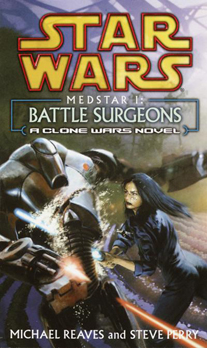In the Season 5 finale of “The Clone Wars,” Barriss Offee goes to the dark side, driven by her frustration with the corrupt Republic and Jedi Order. It came as a surprise to most viewers, who had last seen Barriss as a doting teacher’s pet to her master, Luminara Unduli, in earlier episodes and most of the first phase of “Clone Wars” novels and comics. Of course, the surprise factor is why the writers chose Barriss as the Ahsoka-framing turncoat.
Connections to the Expanded Universe were not taken into consideration by the TV writers, but as is often the case, there are accidental connections to be found if one looks hard enough. Indeed, in “MedStar I: Battle Surgeons” (2004), Padawan Offee – serving sans Luminara as a Jedi healer on war-torn swamp planet Drongar – flirts with the dark side.
She’s not driven by political or ideological reasons, but for the old-fashioned desire to give in to the easy path when fighting a mercenary martial artist who is only nominally on the side of the Republic:
Phow Ji had no idea how close to dying he was just then. Her rage was such that a flicker of a finger would suffice. He’d never know what hit him – and it would even be justice, in a fashion – was he not, after all a killer? Yes, he was – but Barriss Offee was not. … (Not) this time …
Michael Reaves’ and Steve Perry’s “Battle Surgeons” has the page-turning appeal of a pulp novel like Brian Daley’s “Han Solo Adventures,” but rather than being plot and personality-driven like pulps, it’s a collection of slice-of-war character portraits. There’s barely a plot at all. The Republic and the Separatists are fighting on Drongar to control the supply of the wonder drug bota (think of the U.S. military’s involvement in wars near oil fields). But we never see any battle scenes.
Rather, the “MedStar” duology is “Star Wars” meets “M*A*S*H.” The prospect of reading about the grisly details of surgeries made me put off reading this book for a year or so after its initial release, but it’s not particularly gory. At a Rimsoo (a mobile hospital and its surrounding barracks and bar), a handful of colorful characters collide. We see Barriss flirting with the dark side, doctor Jos Vandar and Tolk le Trene flirting with each other, I-Five (introduced in Reaves’ “Darth Maul: Shadow Hunter”) surprising Jos with his human-like droid sentience, a distraught clone trooper surprising Jos with his humanity, and Sullustan journalist Den Dhur (it’s nice to see a newspaperman in “Star Wars”!) taking it all in.
Almost all of the characters are members of the Republic, but that doesn’t stop Reaves and Perry from making some of them unabashedly the bad guys, notably an admiral and a Hutt (!) supply specialist who might be in cahoots to set aside some bota for themselves. I might give the authors too much credit for their characterizations sometimes: In the case of the violence-loving Phow Ji, he seems mysterious and interesting, but by book’s end, I suspected he was simply underwritten.

Something that will irk a few readers is the authors’ overuse of “Star Wars” words. While I love the use of “transparisteel,” “refresher,” “turbolift,” “chrono” and “tunic” – and object to Disney’s recent decision to drop those words from its new novels – Reaves and Perry often get lazy; for example, using “leap-jump” for “hip-hop” and “heavy isotope” for “heavy metal.” And “scape-Drall” instead of “scapegoat?” Really? Also, their characters have an overfamiliarity with flora and fauna of other planets, as when they casually reference wampas or banthas metaphorically. Those are small complaints, but also indicative of why this book is merely good rather than great.
Perhaps there will be more plot and character nuances to absorb in the duology’s conclusion, “Jedi Healer.” But halfway through the story, “MedStar” is enjoyable for the same reason as “M*A*S*H”: A vibrant group of people whose true colors shine through in a series of short episodes set against the horrible backdrop of war.

